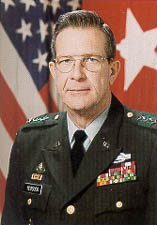
Lt. Gen. John J. Yeosock
Schwarzkopf's organization was unique within the unified command system. For political reasons Central Command headquarters was not in its assigned area of responsibility, and it had few units directly assigned to its command and control. The lack of a headquarters in the Middle East limited the command's familiarity with its potential area of operations as well as its relationships with friendly armed forces of the region. With a mission that demanded the flexibility to respond to contingencies and with long distances between its headquarters and its potential area of operations, Central Command had to be prepared to adapt quickly and on a very large scale.1
At the Senate committee hearings, General Schwarzkopf reviewed the situation in the Middle East, especially in light of the end of the Cold War. He also discussed the effect of the newly emerging world order on Central Command's operational strategy and needs. The committee chairman, Senator Sam Nunn of Georgia, was particularly interested in revising the Defense Department's planning guidance on the Middle East and in the resulting changes in force requirements.
Until shortly before the hearing, the command's planners had concentrated on a scenario involving a Soviet invasion of Iran. Although that assumption remained operative during the 1980s, changes in Eastern Europe and the continuing deterioration of conditions in the Soviet
48
Union made such a possibility less likely by 1990. From Schwarzkopf's perspective, a spillover "of some local conflict leading to a regional war which would threaten American lives and vital U.S. interests" was a more likely threat.2 As he pointed out, there were then thirteen active conflicts in his area of responsibility, some of which had the potential of warranting the commitment of U.S. forces. Central Command had to be concerned with multiple contingency scenarios.
The change in the global situation called for a new look at the command. An amphibious assault on an Iranian beach created different problems than reinforcement of a friendly nation with secure airports and harbors. When asked by Senator Nunn about the type of forces and capabilities that Central Command required with that reorientation, General Schwarzkopf said that he "always had the requirement for the highly mobile contingency forces...that were based in the United States of America, but could rapidly deploy to [any] part of the world."3 In the ensuing six months General Schwarzkopf's command planned on the basis of the concepts he articulated before the Senate committee.
During the spring of 1990 Central Command planners reassessed the threat in their area of responsibility. In light of President Saddam Hussein's increasing bellicosity, they identified Iraq as the most likely aggressor in the region. With Iraq as the potential threat, in March 1990 the command began preparing for a major joint command post exercise, INTERNAL LOOK 90, to test the assumptions of its developing contingency plan for the Middle East. During that computer exercise, Central Command simulated sending forces to the Middle East to deter an attack by "Country Red," to defend critical port and oil facilities, and to defeat enemy forces. The XVIII Airborne Corps had tactical command of the forces, and Army Central Command (ARCENT) had responsibility for sustaining the force.4 Completed in July, the exercise confirmed the basic tenets of operation plan 1002-90.5
General Schwarzkopf and the Central Command staff also began preparing a response to a possible Iraqi invasion two days before Saddam Hussein's troops entered Kuwait. On 31 July and 1 August Schwarzkopf presented deployment options to Chairman of the Joint Chiefs of Staff General Colin Powell, Secretary of Defense Richard B. Cheney, President George H. Bush, and the National Security Council. On 4 August, two days after the invasion, the Central Command commander briefed the president on the availability of sea and air transport. Following that briefing, Schwarzkopf and Secretary Cheney flew to Saudi Arabia to negotiate the deployment of U.S. troops to that country.6
The Department of the Army had begun seriously monitoring intelligence reports coming out of the Middle East in July. Predicting that something was about to happen in Iraq, the Army Staff at the Pentagon began making preliminary assessments of specific Army actions if and when a crisis began. At the end of July, the staff principals met with Vice Chief of Staff General Gordon R. Sullivan to discuss possible Iraqi
49
intentions and military capabilities. At that meeting, each principal recommended a specific course of action should Iraqi troops cross the border into Kuwait. On 1 August the generals met again, this time with the commander of Army Central Command and Third United States Army, Lt. Gen. John J. Yeosock, to review the Army's portion of Central Command's draft operations plan for the Middle East. Realizing that the complications of logistics could create difficulties for any deployment to Southwest Asia, staff members discussed such questions in particular detail. Less than twenty-four hours after that meeting Saddam Hussein invaded Kuwait.7

Lt. Gen. John J. Yeosock
From the beginning the Army Operations Center at the Pentagon had served as the DESERT SHIELD management center for the Department of the Army. A crisis action team, with representatives from each Army Staff element, manned the center on a 24-hour basis, compiling daily comprehensive briefings and updating them continuously. They monitored personnel, equipment, and maintenance requirements for the troops in the field and assisted in correcting shortcomings as they became evident. The center also coordinated the plans for Army support, the allocation of assets to meet worldwide demands, and the dissemination of information to and from the field.
To be able to respond to a variety of tasks and issues during the crisis, the Army Chief of Staff General Vuono and his deputy for operations, Lt. Gen. Dennis J. Reimer, created a strategic planning team. This group, which had six permanent members and added temporary specialists as needed, had responsibility for long-range planning and tried to anticipate Army needs during this time. The team studied such issues as unit rotation, replacement, reinforcement, and reemployment, as well as overall strategy, sustainment, and war termination.8
For this period General Vuono established three principal goals to focus the Army on his own integrated concept of the service's primary short-term and long-range objectives. The first of the goals, which he called vectors, was "to provide all the support necessary to accomplish U.S. national objectives in Operation Desert Storm." The other two, maintenance of a trained and ready force for other commitments and contingencies while reshaping the Army in light of declining post-Cold War resources, required constant attention to the overall state of affairs while prosecuting the war. Thus, throughout operations in Southwest Asia, Army leaders also shouldered the difficult job of preparing to respond to other contingencies in the world while planning to resume the reduction of the Army following the end of hostilities in the Middle East.9
50
agreed to permit the United States to send forces to defend the Kingdom of Saudi Arabia. After hearing Cheney's report, the president approved the deployment of combat forces to the kingdom. Shortly thereafter Cheney issued a directive assigning Central Command the mission to deter and counter any Iraqi aggression against Saudi Arabia.10 A line had been drawn in the sand. The challenge for the U.S. Army and the other services was to turn that line into a substantial barrier through which Iraqi forces could not penetrate.
Shortly after Cheney released his directive, the Joint Chiefs of Staff issued the first DESERT SHIELD deployment order to two F-15 squadrons, Maritime Prepositioned Squadrons 2 and 3, based on the islands of Diego Garcia and Guam; two carrier battle groups; the ready brigade of the 82d Airborne Division; and an airborne warning and control system (AWACS) unit. Cheney's directive unleashed what became the most concentrated and complex projection of American military power since World War 11. Such a massive deployment, however, would not be easy. Several immediate issues required decisions before large-scale troop movements could be carried out, and Central Command had only recently begun to identify its detailed needs for deployment to the Middle East.
Fortunately, during the INTERNAL LOOK exercise the command and its components had examined the requirements for responding to Iraqi aggression in the Middle East. That exercise provided the component commanders a chance to review their plans and requirements and to lay the foundation for subsequent planning. Among early problems confronting the Army and other services was the lack of an updated contingency plan. Although Central Command and its service-component commands worked on a unified campaign plan for the defense of Saudi Arabia during much of 1990, the plan was incomplete and had not yet been presented to the Joint Chiefs of Staff or the services for review. The lack of an approved plan was especially critical in the fluid situation of August. In peacetime once a unified campaign plan was approved, it provided the services with the force requirements that they would have to meet for execution of that plan. In the case of Southwest Asia, comprehensive force lists had to be developed. It took time to identify all the requirements and then match the requirements with specific units. The problem became particularly acute in identifying the many separate units needed to support a large force, among them water purification companies, tactical petroleum terminal units, engineer real estate detachments, and medium truck companies. Planners needed to develop ranges of deployment lists commensurate with service access to reserve capabilities. This process required a political decision by the president on mobilization of the reserves. During 10-28 August more than twenty messages changing the original deployment order passed between Central Command and the Pentagon, reflecting the complexity of the process of identifying specific units.11
51
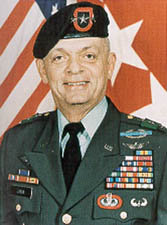
A wartime command structure quickly developed to control the deploying Army units. ARCENT commander General Yeosock arrived in Saudi Arabia on 6 August. With the help of the handful of American officers who had been involved in the modernization of the Saudi Arabian National Guard, he set up an interim headquarters. On 16 August Yeosock set up ARCENT (Main) in Riyadh to oversee the arrival, sustainment, and overall combat planning for deploying Army units. Until General Schwarzkopf arrived in the theater on 25 August, Yeosock, who was commissioned in armor through the Reserve Officers Training Corps in 1959 after graduating from Pennsylvania State University, helped the acting deputy commander in chief, Lt. Gen. Charles A. Homer, U.S. Air Force, prepare for the arrival of the joint force. Yeosock already knew the terrain and climate and was familiar with his Saudi hosts. From 1981 to 1983 he had served in Riyadh as project manager for the modernization of the Saudi Arabian National Guard, and the experience would serve him well in the months ahead.
Once Yeosock went to Saudi Arabia, Maj. Gen. Horace G. "Pete" Taylor, chief of staff of Forces Command, took on the additional duty of ARCENT (Rear) headquarters. So in the early days of the crisis, ARCENT (Rear) helped to generate the requests for forces and filled them in conjunction with Forces Command. During that process General Taylor and General Edwin H. Burba, Jr., the FORSCOM commander, stayed in constant communication with General Yeosock in Saudi Arabia. As Yeosock established his operational headquarters in Saudi Arabia, Forces Command took over the task of building the force.
The first Army units of the XVIII Airborne Corps began deploying to Saudi Arabia on 8 August. The rapid deployment of the ready brigade of the 82d Airborne Division signaled a clear U.S. national commitment to deter further Iraqi aggression. The brigade took its light antitank weapons and M551 Sheridans. Such lightly armed troops would be at risk should Iraq decide to invade Saudi Arabia before the United States completed its force buildup. Nevertheless, the decision made possible a rapid show of force and commitment.
The XVIII Airborne Corps, with its headquarters at Fort Bragg, North Carolina, served as the Army's contingency corps. Its mission required that it be ready to deploy on demand. Lt. Gen. Gary E. Luck had taken
52
82d Airborne Division Deployment Timetable, August 1990
| 8 | 2d Brigade begins to deploy from Fort Bragg, North Carolina |
| 9 | Lead elements of 2d Brigade arrive at Dhahran, Saudi Arabia |
| 13 | 1st Brigade begins to deploy from Fort Bragg |
| 14 | 2d Brigade completes deployment to Saudi Arabia |
| 15 | Advance party and main elements of 1st Brigade arrive in theater |
| 16 | Division headquarters set up at Umm As Sahik |
| 19 | 3d Brigade begins to deploy from Fort Bragg |
| 20 | 1st Brigade completes deployment to Saudi Arabia |
| 24 | 3d Brigade completes deployment to Saudi Arabia |
over the corps in July 1990 after serving over three years as commander of the joint U.S. Special Operations Command and then the Army Special Operations Command. Like Yeosock, he entered the Army with a commission from the Reserve Officers Training Corps. In peacetime Luck had the 101st Airborne Division (Air Assault), the 24th Infantry Division (Mechanized), and the 82d Airborne Division under his command and control. The 101st Airborne Division stationed at Fort Campbell, Kentucky, was an infantry division whose primary means of movement was by helicopter. The 24th Infantry Division, located at Fort Stewart, Georgia, served as the XVIII Airborne Corps' heavy division. A heavy division such as the 24th was structured around, among other factors, the speed, flexibility, mobility, and firepower of its armored tracked vehicles. The 82d, the Army's premier tactical contingency force which routinely had one of its brigades designated as its ready brigade, prepared to begin deployment within eighteen hours of being alerted (Chart 3).
Placed on standby notice on 7 August, the 82d Airborne Division began deploying its ready brigade, the 2d Brigade commanded by Col. Ronald 15 Rokosz, the next day. The first elements left Pope Air Force Base adjacent to Fort Bragg early in the afternoon of 8 August 1990 and began arriving in Dhahran, Saudi Arabia, the following day.13 General Yeosock personally guided the first plane into its parking slot at the airfield.
53
Rokosz's first troops established defenses around the airfield to provide security for the other arriving units. As additional troops came into the country, the perimeter expanded. By the afternoon of 13 August, when the ready brigade reported 100 percent of its troops deployed from Fort Bragg, with 88 percent of them already in Saudi Arabia, it had expanded its area of operations to provide security at Al Jubayl, the port through which the marines would enter the theater. On the fourteenth the 2d Brigade completed its deployment. One battalion of AH-64 attack helicopters from the Aviation Brigade, 82d Airborne Division, accompanied the 2d Brigade.14
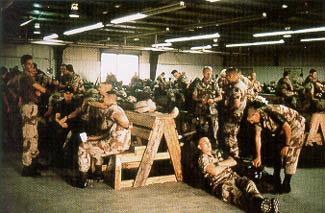
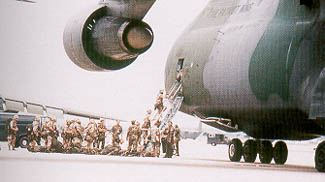
Deployment of the 2d Brigade, 82d Airborne Division, Pope Air Force Base, North Carolina. After waiting in the passenger shed at Green Ramp, soldiers start to board a C-5B for the long flight to Saudi Arabia.
The other two brigades of the 82d quickly followed the ready brigade. The 1st Brigade deployed an advance party on 13 August, which arrived in Saudi Arabia two days later, and completed its deployment on the twentieth. The 3d Brigade began its deployment on 19 August and completed it on the twenty-fourth. Around this time, selected elements of the XVIII Airborne Corps Support Command moved into Saudi Arabia.
While establishing defensive positions and conducting patrols, the soldiers began the long process of adapting to the environment. Their leaders carefully watched water consumption. The soldiers trained and worked only at night, in the early morning, and in late afternoon to limit exposure to the searing desert sun. The sand made its way into everything-weapons, vehicles, clothing, and food- and constant attention was required to make sure equipment and weapons would work when they were needed.
Although the corps' personnel flew to Saudi Arabia, most of their equipment moved by ship. The transshipment of materiel continued through August and September from five Atlantic and Gulf of Mexico ports. Corps support units were loaded at Wilmington, North Carolina.
Other Army units with more specialized missions quickly followed the 82d into Saudi Arabia. Special Forces planners who accompanied the 82d Airborne Division began preparing for the arrival of the 5th Special Forces Group (Airborne), 1st Special Forces. In addition, the lead elements of the 7th Transportation Group from Fort Eustis, Virginia, started their movement to the ports. That unit would control port operations and the unloading of equipment from ships once they docked in Saudi Arabia. On 14 August the commander of the 11th Signal Brigade arrived in theater and began establishing an Army communications network. The first elements
54
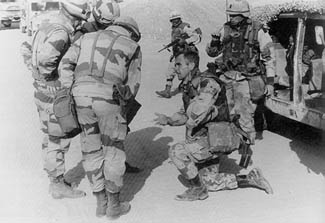
Col. Ronald F. Rokosz (kneeling), commander of 2d Brigade, 82d Airborne
Division, confers with liason officers from the French 6th Light Armored
Division the day before the attack.
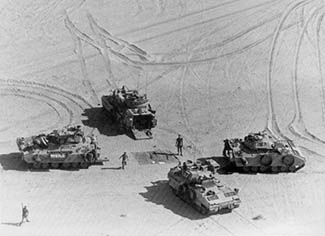
A platoon of Bradleys in the Eastern Province of Saudi Arabia, positioned in a perimeter defense formation
55
of a Patriot missile battery of the 11th Air Defense Artillery Brigade also deployed in early August, and another battery from the 7th Air Defense Artillery arrived in Saudi Arabia on 16 August. The following day, the first aviation elements of the 101st Airborne Division and advance elements of the 24th Infantry Division arrived in theater.15
By the end of the first week of DESERT SHIELD, more than 4,000 Army soldiers had deployed to Saudi Arabia on 106 aircraft. Major weapon systems accompanying the soldiers included 15 AH-64 Apaches, 8 OH-58 Kiowa observation helicopters, 18 M551 Sheridans, 56 TOW antitank missile systems, 2 multiple launch rocket system launchers, and 12 105-mm. towed howitzers. In conjunction with Saudi Arabian forces in the Eastern Province and with deployed forces of the Air Force, Navy, and Marine Corps, Army units took position in the vicinity of Dhahran and A1 Jubayl.
Although the DESERT SHIELD forces continued to deploy at a steady pace, General Schwarzkopf needed more firepower. In the early weeks of the deployment, he anxiously awaited the arrival of the 24th Infantry Division (Mechanized) with its 216 MlA1 tanks. Despite the rapid movement of the Army's first combat units into Saudi Arabia, time and the initiative still remained with Iraq, which had six divisions available in Kuwait to conduct operations with little or no advance warning.16
As General Yeosock and the ARCENT staff had rehearsed in INTERNAL LOOK 90, they planned on deploying initially only the minimum essential
56
support units and creating only a limited logistical base. Priority of deployment went to combat forces. Only later and if necessary would a mature logistics infrastructure be developed. Hence, when XVIII Airborne Corps units arrived in theater, logistical support was virtually nonexistent. Furthermore, the corps support units that were arriving quickly discovered they could not effectively handle the massive deployment of combat troops, who needed food, shelter, equipment, supplies, sanitation facilities, and transportation. General Yeosock quickly realized the need to expand the support system rapidly.
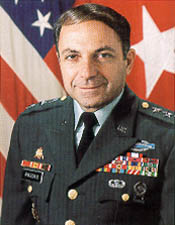
Lt. Gen. William Pagonis
(Rank as of 7 February 1993)
As early as 4 August Yeosock had suggested to Schwarzkopf that Maj. Gen. William G. Pagonis act as ARCENT's deputy commander for logistics. Yeosock had been impressed with Pagonis during a REFORGER exercise some years earlier, in which troops and equipment from the United States rehearsed deployment to Germany for a possible European war. At the time, Pagonis, a veteran logistician and another Reserve Officers Training Corps graduate of Pennsylvania State University, was serving as deputy chief of staff for logistics at Forces Command.
Burba readily agreed to the transfer, and by 7 August Pagonis was on his way to Saudi Arabia to set up a program for Saudi support of American forces. Four hand-picked logisticians-Cols. Stephen J. Koons, John B. Tier, and Robert Klineman and Lt. Col. James Ireland-went with him, and the remainder of his personally selected 22-man team joined him within a few days. Pagonis landed in Riyadh on 8 August, scant hours before the first transport carrying the ready brigade of the 82d Airborne Division hit the tarmac at Dhahran, 250 miles away.
While en route to Saudi Arabia, Pagonis and his four staff officers had drafted a logistics plan for the theater. All had participated in REFORGER exercises, which provided the model for creating their DESERT SHIELD plan. The group outlined three major tasks necessary to create a sound logistics system in theater: the reception, onward movement, and sustainment of all soldiers, equipment, and supplies. Pagonis and his four subordinates took their proposal to Yeosock's headquarters in Riyadh. At that point, Yeosock formally designated Pagonis his deputy for logistics.
When Pagonis arrived at Dhahran the next day, he was appalled at what he found there. The initial combat troop arrivals had quickly overwhelmed the local resources. Colonel Ireland later recalled that as the soldiers poured in, "we just didn't have anything. We had...soldiers here with no place to put them, no way to get them out there if we did have a place to put them, and difficulty feeding them." Soldiers slept on the sand and on handball and tennis courts. Hundreds slept on the ground behind the quarters occupied by the United States Military Training Mission to Saudi Arabia and dug slit trenches for latrines.18
Three American officers from the training mission frantically tried to process the incoming soldiers from the XVIII Airborne Corps, who had started to arrive late in the morning of 9 August.19 The training mission had no significant transportation resources of its own, so the
57
officers arranged for Saudi buses and trucks to take the troops to a vacated air defense facility 15 miles from the airport. With no personnel, no facilities, no resources, and very little information, those three officers made the best of a bad situation and provided whatever support they could, but the overwhelming demands quickly took a physical toll. His staff officers "looked like zombies," Pagonis later recalled. "They hadn't slept for...days."20
After the first night in Dhahran, Pagonis and his small staff took over two rooms in the training mission's building, one for bunks and another for an operations center. The staff quickly outgrew the two rooms and moved to the mission's recreation center, which they dubbed the "Hotel California." For the first three days, there was practically no rest.
The trickle of troops and equipment turned into a torrent with each passing day, and General Pagonis quickly decided that a full support command would be needed. His first priority was to find help to accomplish the myriad tasks involved in bringing units into the country and then supplying them because deploying units had placed their own organic support units at the end of the flow.21 While waiting for the rest of his immediate staff to reach Saudi Arabia, Pagonis got assistance from units already on hand, putting together an ad hoc theater support organization. Newly arrived combat units routinely provided temporary help to round out the support command staff. When support units arrived, some of their people also joined the support command for an extended period. As General Pagonis put it, "anybody who had an Army uniform on, we just acquired them and said they worked for us."22
On 11 August the arrival of the 7th Transportation Group improved the situation. At that time, Pagonis had a staff of only ten, so he incorporated nearly one hundred members of Col. David A. Whaley's advance party into his own organization. In a short time, newly arriving members of the 7th Transportation Group and recalled reservists reconstituted the command, which was already at work operating the seaports. The evolving logistical command and control organization thus was a highly personalized, tailored headquarters that was shaped by the demands of a rapidly changing situation and the dire shortage of trained logisticians and their functional staffs.23
58
Reserve components in this program planned and trained during peacetime with designated wartime commands, and development of a relationship hinged on associations built during training between Regular Army and reserve units. This relationship included links between active combat units and the reserve roundout organizations that had been designated by the Army to fill out and bring the combat units to full strength. Regulations specified that the roundout units would deploy with their active-duty sponsors based on the priorities of the theater commander to whom they would report.24
Maj. Gen. Alvin W. Jones, U.S. Army Reserve, commanded the 377th, a reserve unit from New Orleans, Louisiana, that had an authorized strength of 416. Under the Capstone program, the 377th's relationship with Third Army meant that it had concentrated its planning almost exclusively on Southwest Asia as a projected area of operations since Third Army was the designated Army component of Central Command. The 377th had helped draft the combat service support annexes of all the contingency operation plans for Southwest Asia and had geared all of its standing operating procedures to those operations. All of the 377th's training, including participation in three BRIGHT STAR exercises in 1985, 1987, and 1990, were built around Middle East scenarios. It had only one unit under its direct control, the 321st Support Center (Theater Army), which provided supply and materiel management at the corps support command level. In addition, the 377th had almost two hundred units in its Capstone trace, which was the specific support units that it was projected to control in the event of a national emergency.
When President Bush authorized the activation of the reserves on 22 August, Forces Command alerted the 377th. However, a division of opinion quickly developed over its possible deployment. The Army Staff and Forces Command generally supported activating the 377th, while Central Command and Army Central Command opposed it. The limited reserve call-up authority might well curtail the length of time the 377th would be available for active duty. Moreover, by the time the organization was alerted, General Pagonis had already hand-picked his staff and assembled a functioning support organization. Installing a new headquarters, he believed, would disrupt the system at a critical juncture. General Vuono in Washington, working to provide the commanders in the theater of operations with what they wanted, felt that, rather than an additional headquarters, the commanders wanted units to flesh out their existing logistics organization.25 On 27 September Forces Command dropped the 377th Theater Army Area Command from the alert list.
59
tents, blankets, and medical supplies, as well as refrigerated trailers, reverse osmosis water purification units, forklifts, and tactical petroleum terminals. Those ships, which had been stocked and positioned so that they could support an expeditionary force such as the one now deploying, arrived at Saudi Arabian ports on 17 August. They bought time for Pagonis to put into operation a more formal logistics system. "There was no doubt about it," Pagonis later said. "We would have never made it if we did not have those four Army pre-po ships."26
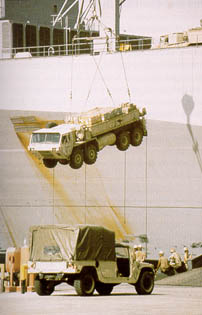
Unloading at a Saudi port
Within two weeks of General Pagonis' arrival in the theater, Army Central Command took steps to formalize the logistical operation. On 17 August Yeosock appointed Pagonis commander of ARCENT (Forward) to provide supervision for the increasing number of noncorps units assigned to the Dhahran area. Two days later the organization became an institutionalized ARCENT subordinate unit, the Provisional Support Command, using a standard theater army area command table of organization and equipment.
By the end of August the staff, slowly gaining control of the situation at the airport, began devoting more time to planning for anticipated long-term requirements. On 27 August General Pagonis created a conventional general staff and two days later moved to the training mission headquarters at the King Abdul Aziz Air Base.27 By 31 August the support command's total strength, headquarters and subordinate units, stood at 2,291. Temporary personnel loans from the United States Army, Europe, staff and the reassignment of selected personnel from the ARCENT staff helped fill out the headquarters.
Pagonis and his staff built their logistics infrastructure while receiving and moving troops. Within fifteen days after assuming responsibility for the airport, they processed over 40,000 soldiers, formed an area support group and an area support battalion, and started unloading ships. By the end of September the Provisional Support Command moved over 100,000 people and discharged thirty-nine ships. In addition to serving its own elements, Pagonis' command supported the other Central Command component services-Navy, Air Force, and Marine Corps- once they were ashore in theater. The Army was also the point of contact for food, water, bulk fuel, ground munitions, port operations, inland cargo transportation, construction support, veterinary services, and graves registration for all U.S. forces, either providing the support directly or arranging for it through contracting or host nation support assets.
60
Saudi Arabia was not a backward, primitive state. Soaring oil revenues in the 1970s had enabled the kingdom to make major investments in public works. The telephone system ranked with the finest anywhere, although it ultimately proved too small to accommodate the demands of the coalition force, to which thirty-eight countries contributed.28 The port of Ad Dammam may have been the best in the world. It and Al Jubayl had modern facilities, with immense capacities and staging areas. Airports, particularly Dhahran, were large and modern, and the primary road system was well built although inadequate for the high volume of traffic that a large military force would generate. Yet, with a total population of about seven million, the country just could not provide for the day-to-day needs of hundreds of thousands of soldiers.
The construction boom of the 1970s did at least present potential solutions to some of the problems involved in supporting the U.S. force. Huge public housing projects, designed initially for a growing population of expatriate workers and citizens migrating to the city, stood largely unoccupied. The U.S. Army did at least have a potential source for troop housing near ports of entry.
The establishment of a formal agreement for the use of resources available
in Saudi Arabia proved critical to logistical success. Such an arrangement,
known as host nation support, covered all assistance to allied forces
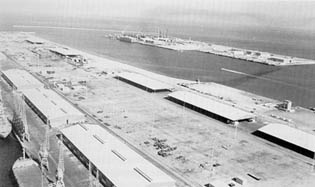
The port of Ad Dammam
61
and organizations located in the host nation's territory. An agreement for peacetime and wartime help had long been in force between the United States and the Federal Republic of Germany, where the United States had thousands of soldiers, but none covered the American presence in Saudi Arabia. On 15 August General Pagonis had set up a staff section in his headquarters under Col. Roger W Scearce to deal with host nation support matters. Scearce was succeeded from October to early January by Lt. Col. Donald L. Trautner and finally by Col. Robert H. Sholly.29
Because of the fluid situation in August, contracting activities were conducted in a very decentralized and informal manner. Initially there were no controls, and people at all levels did their own contracting. Many untrained individuals became involved in negotiations for critically needed resources and services. For example, second lieutenants in brigades were going out and buying brooms. Experienced contracting officers from the XVIII Airborne Corps, therefore, provided an invaluable service to the Provisional Support Command. By the end of the month Yeosock established a contracting office. In addition to initial billeting and transportation, contracting provided latrines, washbasins, and showers, as well as forklifts, food, water, fuel, and a variety of other supplies and services.30
Efforts to find billeting and to move troops from Dhahran revealed the unstructured nature of contracting activities in August and early September. In one case, Lt. Col. James Ireland, the acting support command headquarters commandant, heard about empty Saudi housing nearby. Desperate for more space, he dropped what he was doing, drove to the site, decided that the price was reasonable, and said he would take it. In another case, Lt. Col. Michael E. Velton cruised the streets of Dhahran looking for idle buses or trucks. Whenever he saw a group of vehicles, he tried to negotiate a deal. There was no time for the formal contracting process. "We were," Velton said, "literally out contracting for the buses while they [U.S. troops] were landing at the airport." He gave a Saudi entrepreneur a bag with $40,000 in cash, got a receipt, and waited for his trucks and buses. To his immense relief, the vehicles arrived as promised, and the soldiers moved off the airfield.31
The idiosyncrasies of the Saudi Arabian bureaucracy added to the challenge of contracting. Often the Saudis would deal only with officers, preferably high-ranking officers. They refused to negotiate with an Arabic-speaking chief warrant officer in the Provisional Support Command's contracting office, so he wore a major's gold leaves when he did business with them. The practice of temporarily "commissioning" or "promoting" people occasionally smoothed business dealings.32
The Saudi Arabian government never intended to let the United States shoulder all of the expenses of the deployment. As early as 18 August the logistics operations center developed a list of the command's basic needs for host nation support for the next forty-five days. The Saudis reacted energetically and cooperatively, providing tents, food, transportation, real estate, and civilian labor support.33
62
HOST NATION SUPPORT REQUIREMENTS a
| Products/Services | Quantity |
|---|---|
| Water | 15 million gallons/day |
| Ice | 95 short tons/day |
| Subsistence (A-rations) | 270,000 meals/day |
| Tents | 8,416 |
| Fuel | |
Gasoline |
181,000 gallons/day |
Diesel |
120,000 gallons/day |
Jet |
52,000 gallons/day |
| Vehicles | |
Buses |
700 each |
Trucks |
12,150 (various sizes) |
POL tankers |
380 (various types) |
Water tankers |
300 (various types) |
| Hygiene | |
Latrines |
2,700 units |
Showers |
2,250 units |
Laundry |
40,000 bundles/day |
Refuse collection |
145,000 short tons/day |
a For period C+12 (19 Aug 90) to C+56 (2 Oct 90) based on a force of 135,000.
Source: Draft MS, John J. McGrath and Michael D. Krause,
Theater Logistics and the Gulf War [1992], p. 151.
On 10 September King Fahd verbally committed his nation to provide comprehensive support, although the details remained unclarified until mid-October, when the Department of Defense sent a negotiating team to Saudi Arabia. Instead of concluding a contract or international agreement with the Saudis, the team reached an understanding which became a de facto agreement. That was done to prevent bureaucratic delays and to make giving a gift from Saudi Arabia to the United States as easy as possible, while addressing the kingdom's continuing desire to avoid formal ties. Saudi Arabia agreed to pay the costs of all contracts entered into by U.S. forces as of 30 October 1990 and backed up its promise with a check for $760 million that a very nervous American officer carried back to New York for deposit. Saudi Arabia agreed to pay for all freshly prepared meals-known as Class A meals or A-
63
rations in the Army, water, fuel, transportation within Saudi Arabia, and facilities, including construction. By December that assistance was valued at about $2.5 billion projected over one year. American forces still could negotiate for themselves if the Saudis did not meet their needs, but the United States would pay for those contracts.34
In time the system of Saudi support and contracting matured and helped sustain American forces in theater, but the need to move the troops and their equipment from the ports still presented tremendous challenges. Both sat waiting for transportation, as it became apparent that unloading equipment at the ports was easier than delivering it to cantonments. The port of Ad Dammam, which before the crisis had averaged only six ships a week, handled that many every day after the crisis began.35 Ground transportation provided the key link between the ports and assembly areas.
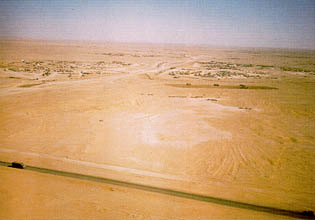
Tapline Road passing through logistical base CHARLIE
Map 5 Supplying the Troops December 1990
The southern route also consisted of two main supply routes. An excellent multilane road running between Dhahran and Riyadh was named TOYOTA. The last segment, SULTAN or NASH, ran north from Riyadh to Hafar al Batin, where it intersected DODGE. SULTAN was a multilane road for about one-third of the distance north from Riyadh before narrowing to two lanes. Some of these roads were well surfaced and in good repair, but there were not enough of them for the high volume of traffic.
The distances were great, 334 miles from Dhahran to the theater logistical base at King Khalid Military City near Hafar al Batin along the northern main supply route and 528 miles via Riyadh. The XVIII Airborne Corps' forward tactical assembly area was over 500 miles from Ad Dammam by the northern route and 696 by the southern road. The highways thus became high-speed avenues for combat units and supplies moving to their destinations. Because large stretches were multilane roads they allowed heavy volumes of traffic to move fast, both as individual vehicles and as convoys. Even those roads that were not multilane were paved and in generally good condition.
To increase the efficiency of the road network, General Pagonis established a series of convoy support centers. Those truck stops operated twenty-four hours a day and had fuel, latrines, food, tents for sleeping, and limited repair facilities. They added to the comfort, safety, and morale of allies
65
traveling in the theater and greatly enhanced the ability of the transporters. Because of the long distances, the primitive rest areas quickly became favorite landmarks to those who drove the main supply routes.
With excellent ports and durable roads, all the Army needed was the means to move equipment and supplies. The oil industry had traditionally needed large vehicles to transport heavy equipment to various well sites, so there were many heavy equipment transporters as well as tractor-trailer cargo trucks in the country. The growing wealth of the kingdom with an increased urban population and an expanding pool of expatriate workers meant a large fleet of buses. Likewise, expanding interaction with the West had prepared the business community with how to deal with Americans and had provided a relatively sophisticated core of bureaucrats and decision makers to deal with the overwhelming demands placed on their economy.
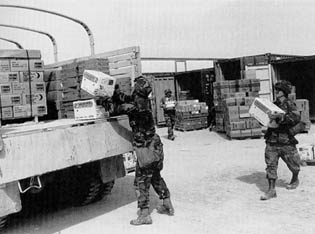
Rations for the troops
Wolf thought that it was foolish to feed soldiers from prepackaged meals when A rations could be used. He contended that the Army had done poorly by its soldiers, taking away cooks and refrigerated vans and substituting T-rations for fresh food. A-rations improved troop morale and preserved the valuable limited supply of MREs for potential combat operations.
Before he managed to put his ideas into practice,
66
the influx of soldiers severely strained the ability of the system to supply MREs. During the early days of the deployment, the stock dwindled to one-half day's worth. When the XVIII Airborne Corps arrived, Wolf distributed a "horrendous amount of MRE's" because he had no caterers. As Wolf put it, "if it wouldn't have been for the A-rations that we were receiving from the host nation, we would have run out of food."36
Wolf worked with the Saudi's to set up dining halls operated by local contractors. When Army units landed without their cooks and field mess equipment, they would use a contract mess hall. If units did not have cooks, they would use the contract mess hall on a permanent basis. The kingdom did not have any large caterers, so at first only one contract mess operated in the Dhahran area, at the XVIII Airborne Corps' "Dragon City." That first effort served unfamiliar Saudi cuisine, which the troops did not appreciate. As the American presence increased, so too did the local kitchen expertise. Soon contract mess halls fed American troops in Riyadh, Dhahran, A1 Jubayl, King Khalid Military City, and other locations. While indigenous contractors learned to operate from the Army's ten-day feeding menu and to prepare American meals, Army veterinarians inspected locally purchased food to ensure that it met American standards.
In another effort to conserve MREs, Wolf implemented a program of supplements. He wanted to serve fruit, juice or soft drinks, pastries, and bread with jelly or some other sandwich filler with an MRE at noon. Wolf hoped the soldiers would eat only part of their MRE and save the other part, cutting consumption of the critical operational meals. The program succeeded, and with time, especially when the MREs were critically short, the supplement became the only issue for the noon meal. General Pagonis christened it the "fruitbasket in every foxhole" program.37
Empty public housing projects ultimately provided the solution to many transient billeting problems. Those projects were large complexes of duplex-style villas and high-rise apartments. Ultimately, most of the Americans assigned to Riyadh lived in Eskan Village, a massive complex with modern duplexes featuring marble floors, four and five bedrooms, and two or three baths. These had been originally built for Western workers. They housed the American troops and provided ample office space as well.
67
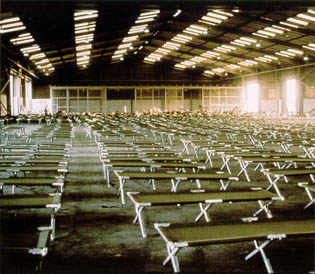
Temporary quarters in a warehouse, used by 24th Infantry Division Soldiers after their arrival in Saudi Arabia
In Dhahran the Saudis turned over a similar high-rise complex to the Americans. A1 Khubar Village consisted of 219 multistory apartment buildings with over 4,100 apartments. Here also the floors were marble, even in the stairwells, and each apartment was very spacious. At times, as the American buildup continued, over 23,000 soldiers would be crammed in the apartments. As many as eight or ten to a room, they waited for their equipment to arrive so their unit could move to its tactical assembly area in the desert. In the early days facilities were procured primarily by imaginative officers who hunted them out and arranged leases through the host nation support office. Nevertheless, transient units still relied heavily on tents and warehouses.38
Despite the confusion suggested by the extemporaneous solutions to feeding, housing, and moving the incoming soldiers, Army Central Command could point to great progress during the first month in Saudi Arabia. By early September the entire 82d Airborne Division and the first elements of the 24th Infantry Division had arrived. The rest of the 24th and the 101st Airborne Division were on the way. The partnership with the Saudi government was evolving well, and a logistical support organization was emerging. The SHIELD was in place.
Notes
1. U.S. Congress, Senate, Committee on Armed Services, Threat Assessment; Military Strategy; and Operational Requirements, 101st Cong., 2d sess., 1990, p. 718.
2 ibid., p. 587.
3 ibid., p. 713.
4 Draft MS, Col Richard A Swain, Operational Narrative: Operations DESERT SHIELD-DESERT STORM, pp. 3-5.
5 Draft MS, Capt Lawrence Douglas, U.S. Navy Reserve (USNR), CENTCOM History, pp. 1-2.
6 ibid., p. 10.
7. Interv, Richard Hunt and Theresa Kraus with Col Michael Harper, Chief, Army War Plans, 20 Mar 91, C MH transcript no. DSIT-C-0 17.
8. Interv, Theresa Kraus and Stephen Everett with HQDA staff, Mar and Jun 91; Vuono interview, 3 Aug 92. Army Regulation (AR) 500-5, The Army Mobilization and Operations Planning System (1986).
9. Michael P. W. Stone and Carl E. Vuono, Maintaining a Trained and Ready Total Force for the 1990s and Beyond, A Statement on the Posture Of the United States Army, Fiscal Years 1992 and 1993 (N.p.: 1991), p. 2.
10. Memo for Secretary of the Army/Chief of Staff of the Army, 8 Aug 90, sub: Army Operations Update-Information Memorandum Number 1.
11. Msg, Commander in Chief, Forces Command (CINCFOR), to Chairman, joint Chiefs of Staff (CJCS), 28 Aug 90, sub: Sitrep Number 21.
12. Draft MS, Swain, Operational Narrative, pp. 14-15.
13 Msg, CINCFOR to CJCS, 8 Aug 90, sub: FORSCOM Sitrep.
14 Msg, Cdr, XVIII Airborne Corps, to CINCFOR, 14 Aug 90, sub: XVIII Abn Corps Sitrep No. 7; Msg, Commander, U.S. Army Central Command (COMUSARCENT), to Commander in Chief, Central Command (USCINCCENT), 13 Aug 90, sub: ARCENT Sitrep; FORSCOM, CENTCOM, ARCENT and XVIII Airborne Corps Daily Sitreps, Aug 90.
15 Msg, Cdr, Transportation Center (TRANSCEN), Fort Eustis, Va., to Cdr, Forces Command (FORSCOM), Fort McPherson, Ga., 14 Aug 90, sub: Installation Sitrep 002; Memo for the Secretary of the Army/Chief of Staff of the Army, 16 Aug 90, sub: Army Operations Update, Operation DESERT SHIELD Information Memorandum Number 9; Draft MS, Swain, Operational Narrative, pp. 21-22.
16 Information Paper, DAMO-AOC, 14 Aug 90, sub: Current Operations Situation, 141100 Aug 90; Msg, Cdr, XVIll Airborne Corps, to CINCFOR, 14 Aug 90, sub: XVIII Abn Corps Sitrep No. 7.
17 Msg, Cdr, XVIII Airborne Corps, to CINCFOR, 9 Aug 90, sub: XVIII Abn Corps Sitrep No. 3.
18 Quote from Interv, Maj William W. Epley and Maj Glen R. Hawkins with Lt Col James Ireland, 25 Feb 91. Interv, Lt Col Wesley V. Manning and Maj Glen R. Hawkins with Col David A. Whaley, 13 Feb 91.
19 Msg, CINCFOR (J3-CAT [Crisis Action Team]) to CJCS, 9 Aug 90, sub: CINCFOR Sitrep No. 3.
20 Quote from Pagonis interview, 3 Oct 90. Ireland interview, 25 Feb 91.
21 Interv, Maj Larry Heystek with Maj William G. Pagonis, 3 Oct 90; Msg, ARCENT (Forward) to FORSCOM, 9 Aug 90, sub: LogSitrep 1.
22 Pagonis interview, 3 Oct 90.
23 Whaley interview, 13 Feb 9 1.
24 AR 11-30, CAPSTONE Program (1983).
25 Vuono interview, 3 Aug 92.
26 Pagonis interview, 3 Oct 90.
27 22d Support Command (SupCom), DESERT SHIELD Command Rpt, 23 Mar 91, p. 2; Interv, Maj Glen R. Hawkins with Lt Col John J. Carr, 15 Feb 91; Ireland interview, 25 Feb 91
28 U.S. Department of Defense, Conduct of the Gulf War: Final Report to Congress (Washington, D.C.: Government Printing Office, 1992), app. 1.
29 Richard F. Nyrop, ed., Saudi Arabia, A Country Study, 4th ed. (Washington, D.C.: Government Printing Office, 1984), ch. 3; Field Manual (FM) 55-2, Division Transportation Operations (1985), p. glossary-4.
30 22d SupCom, DESERT SHIELD Command Rpt, 23 Mar 91, p. 9 and tab J; Memo, ARCENT Contracting Command, 10 Mar 91, sub: Command Report for Operation DESERT SHIELD, Interv, Maj Glen R. Hawkins with Lt Col Don Trautner, 12 Apr 91.
31 Ireland interview, 25 Feb 91. Quote from Interv, Lt Col Wesley V. Manning and Maj Glen R. Hawkins with Lt Col Michael Velton, 2 Feb 91.
32 Whaley interview, 13 Feb 91.
33 Memo, SupCom Assistant Chief of Staff, Host Nation Activities, 2 Oct 90, sub: Historical File, dtd 2 October 1990, pp. 3-5 and attachment 5; 22d SupCom, DESERT SHIELD Command Rpt, 23 Mar 91, p. 9; Draft MS, John J. McGrath and Michael D. Krause, Theater Logistics and the Gulf War [1992], p. 151.
34 Interv, Maj Glen R. Hawkins with Robert Gorman, senior attorney, Office of the Assistant General Council (Logistics), Department of Defense (DOD), 12 Apr 91.
35 Interv, Maj Glen R. Hawkins with Col Daniel G. Brown, 15 Jan 91.
36 Interv, Lt Col Wesley V. Manning and Maj Glen R. Hawkins with CW04 Wesley C. Wolf, 16-17 Feb 91.
37 Ibid.
38 Memo, SupCom Assistant Chief of Staff, Host Nation Activities, 1 Jan 91, sub: Historical File, p. 4; Ireland interview, 25 Feb 91.
page updated 7 June 2001
Return to the Table of Contents